
The Rowrah and Kelton Fell Railway was a standard gauge mineral railway in Cumberland, England, which was operated by William Baird and Company of Glasgow, Scotland. It opened in 1877 and closed in 1926. [1]

The Rowrah and Kelton Fell Railway was a standard gauge mineral railway in Cumberland, England, which was operated by William Baird and Company of Glasgow, Scotland. It opened in 1877 and closed in 1926. [1]
The line ran south from Rowrah to Sheriff Gate where it branched into three. One line ran south-west to Salter Hall Quarry; a second ran south to Stockhow; a third ran east to Kirkland, for Bankstead mine. The Kirkland branch continued east to Kelton Fell and Knockmurton mines. There were junctions with both the Whitehaven, Cleator and Egremont Railway and the Cleator and Workington Junction Railway near Rowrah. [2] [3]
| Name | Wheels | Builder | Notes |
|---|---|---|---|
| ? | 0-6-0ST | ? | ex-Whitehaven, Cleator and Egremont Railway |
| Salter | 0-4-0ST | Manning Wardle | |
| Wyndham | 0-6-0ST | Manning Wardle | |
| Dinah | 0-6-0ST | Manning Wardle | |
| Derwent | 0-6-0ST | Manning Wardle | Purchased 1925 from Moor Row Iron Mines |
Knockmurton mine closed about 1920; Bankstead mine closed 1921; Salter Hall quarry and the railway closed 1926. The track was lifted in 1934.

Workington Central railway station was opened by the Cleator and Workington Junction Railway (C&WJR) in 1879 to serve the town of Workington in Cumberland, England. It was situated almost half a mile nearer the town centre than its rival Workington station.

Rowrah is a village in Cumbria, England, and spans the civil parishes of Arlecdon and Frizington and Lamplugh. The majority of Rowrah is within Arlecdon and Frizington. The parish boundaries are formed from the Windergill Beck and Colliergate Beck: as such nine properties, Rowrah Hall Farm, Rowrah Hall, Ainsdale House, Rowrah Head, four properties on Pheasants Rise and Rowrah Station technically fall within Lamplugh.

Moor Row railway station was built by the Whitehaven, Cleator and Egremont Railway. It served the village of Moor Row, Cumbria, England.

Cleator Moor has had three passenger stations:

Cleator Moor West railway station was opened as "Cleator Moor" by the Cleator and Workington Junction Railway (C&WJR) in 1879. It served the growing industrial town of Cleator Moor, Cumbria, England.
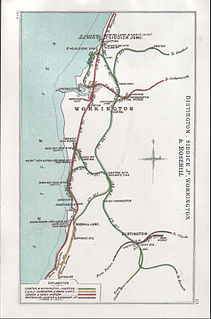
High Harrington railway station was opened by the Cleator and Workington Junction Railway (C&WJR) in 1879. It was situated half a mile south of Harrington Junction on the company's main line. and served what was then the eastern extremity of Harrington in Cumbria, England. The station is not to be confused with the current Harrington station a kilometre away on the coastal line.
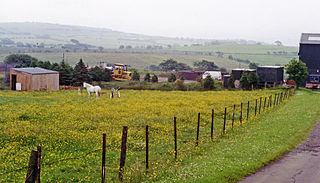
Arlecdon railway station served the village of Arlecdon in the former English county of Cumberland, now part of Cumbria.

Seaton railway station served the village of Seaton, near Workington in Cumberland, England.
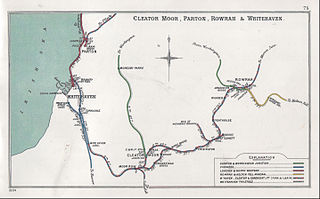
Rowrah railway station was built by the Whitehaven, Cleator and Egremont Railway. It served the village of Rowrah, Cumbria, England.

Winder railway station was built by the Whitehaven, Cleator and Egremont Railway. It served the village of Winder, Frizington, Cumbria, England.

Yeathouse railway station was a later addition to the Whitehaven, Cleator and Egremont Railway. It served the communities of Yeathouse and Eskett, near Frizington, Cumbria, England.

Frizington railway station was built by the Whitehaven, Cleator and Egremont Railway. It served the industrial Parkside area of Frizington, Cumbria, England.
Moresby Junction Halt railway station was opened by the Cleator and Workington Junction Railway (C&WJR) in 1910. Very few people lived near the halt, which served nearby Walkmill Colliery and coke ovens in Cumbria, England.
Keekle Colliers' Platform railway station was opened by the Cleator and Workington Junction Railway (C&WJR) in July 1910, closed the following January, reopened in June 1913 then closed for good on 1 October 1923. The halt was provided to enable residents of the isolated Keekle Terrace, less than 100 yds from the track, to get to and from work at the equally isolated Walkmill Colliery and coke ovens in Cumbria, England. The Platform is not shown by Jowett.

Moresby Parks railway station was opened by the Cleator and Workington Junction Railway (C&WJR) in 1879. It was situated just north of the summit of the company's main line and served the scattered community of Moresby Parks in Cumbria, England.
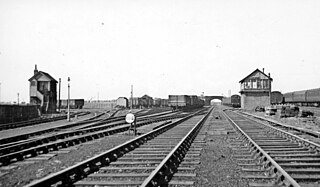
Harrington Junction was a railway junction in Harrington, Cumbria, England. It joined three branches to the Cleator and Workington Junction Railway's (CWJR) main line from Workington Central to Moor Row via Cleator Moor West. No station ever existed at the junction, High Harrington was the nearest, 48 chains (0.97 km) to the south.
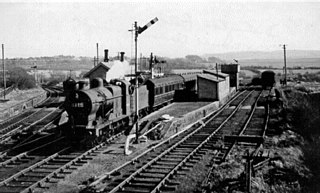
Distington railway station was opened jointly by the Cleator and Workington Junction Railway (C&WJR) and the LNWR and Furness Joint Railway on 1 October 1879. It was situated on the northern edge of the village of Distington, Cumbria, England where the C&WJR's north-south main line crossed the Joint Line's east-west Gilgarran Branch.

Rosehill railway station was opened by the Cleator and Workington Junction Railway (C&WJR) on the company's Harrington Branch which connected with the Lowca Light Railway (LLR) at Rosehill to provide a through route from Lowca to Workington Central and beyond.

Siddick Junction railway station was opened by the Cleator and Workington Junction (C&WJR) and London and North Western Railways in 1880 to provide exchange platforms for passengers wishing to change trains from one company's line to the other. A passenger travelling from Maryport to Distington, for example, would change at Siddick Junction. As a purely exchange station - like Dovey Junction and Dukeries Junction elsewhere in the country - the owning companies would not need to provide road or footpath access or ticketing facilities as no passengers were invited to enter or leave the station except by train.

Oatlands railway station served the village of Pica and Oatlands Colliery in the former English county of Cumberland, now part of Cumbria.